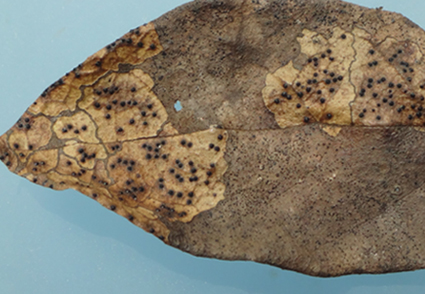Abstract
During an ongoing investigation of species in the family Rhytismataceae in Mt Huangshan, Anhui Province, China, we discovered a morphologically distinct species of Terriera on fallen leaves of Loropetalum chinense (Hamamelidaceae). Multigene phylogenetic analyses (ITS, nrLSU, mtSSU) combined with morphological characteristics of the ascomata, asci and paraphyses, confirmed the distinctiveness of this species. It is described here as a new species, Terriera longiparaphysium.
References
- Cai, S.R., Wang, S.J., Lv, T. & Hou, C.L. (2020) Three new species of Terriera (Rhytismatales, Ascomycota) from China. Mycological Progress 19: 825–835. https://doi.org/10.1007/s11557-020-01594-4
- Cannon, P.F. & Minter, D.W. (1986) The Rhytismataceae of the Indian subcontinent. Mycological Papers 155: 1–123.
- Chen, L., Minter, D.W., Wang, S.J. & Lin, Y.R. (2013) Two new species of Rhytismataceae on fagaceous trees from Anhui, China. Mycotaxon 126 (1): 109–120. https://doi.org/10.5248/126.109
- Eriksson, B. (1970) On Ascomycetes on Diapensiales and Ericales in Fennoscandia. Symbolae Botanicae Upsalienses 19 (4): 1–71.
- Farris, J.S., Kallersjö, M., Kluge, A.G. & Bult, C. (1994) Testing significance of incongruence. Cladistics 10: 315–319. https://doi.org/10.1111/j.1096-0031.1994.tb00181.x
- Gardes, M. & Bruns, T.D. (1993) ITS primers with enhanced specificity for basidiomycetes-application to the identification of mycorrhizae and rusts. Molecular Ecology 2: 113–118. https://doi.org/10.1111/j.1365-294X.1993.tb00005.x
- Guo, M.J., Zhuo, L., Wang, S.J., Sui, X.N., Zhou, H., Cai, S.R., Luo, J.T., Lei, R.H., Shen, X.Y., Piepenbring, M. & Hou, C.L. (2024) Hyperdiverse Rhytismatales on twigs of Rhododendron spp. Mycosphere 15 (1): 764–880. https://doi.org/10.5943/mycosphere/15/1/6
- Hall, T.A. (1999) BioEdit: a user-friendly biological sequence alignment editor and analysis program for Windows 95/98/NT. Nucleic Acids Symposium Series 41 (41): 95–98.
- Hou, C.L., Li, L. & Piepenbring, M. (2009) Lophodermium pini-mugonis sp. nov. on needles of Pinus mugo from the Alps based on morphological and molecular data. Mycological Progress 8: 29–33. https://doi.org/10.1007/s11557-008-0575-z
- Huelsenbeck, J.P., Ronquist, F., Nielsen, R. & Bollback, J.P. (2011) Bayesian inference of phylogeny and its impact on evolutionary biology. Science 294: 2310–2314. https://doi.org/10.1126/science.1065889
- Johnston, P.R. (1988) An undescribed pattern of ascocarp development in some non-coniferous Lophodermium species. Mycotaxon 31 (2): 383–394.
- Johnston, P.R. (2001) Monograph of the monocotyledon-inhabiting species of Lophodermium. Mycological Papers 176: 1–239.
- Lantieri, A., Johnston, P.R., Park, D., Lantz, H. & Medardi, G. (2012) Hypoderma siculum sp. nov. from Italy. Mycotaxon 118 (1): 393–401. https://doi.org/10.5248/118.393
- Lantz, H., Johnston, P.R., Park, D. & Minter, D.W. (2011) Molecular phylogeny reveals a core clade of Rhytismatales. Mycologia 103 (1): 57–74. https://doi.org/10.3852/10-060
- Matsukura, K., Hirose, D., Kagami, M., Osono, T. & Yamaoka, Y. (2017) Geographical distributions of rhytismataceous fungi on Camellia japonica leaf litter in Japan. Fungal Ecology 26: 37–44. https://doi.org/10.1016/j.funeco.2016.11.006
- Nylander, J. (2008) MrModeltest2 version 2.3 (program for selecting DNA substitution models using PAUP*). Evolutionary Biology Centre, Uppsala, Sweden.
- Page, R.D. (1996) TreeView: an application to display phylogenetic trees on personal computers. Bioinformatics 12 (4): 357–358. https://doi.org/10.1093/bioinformatics/12.4.357
- Ronquist, F., Teslenko, M., van der Mark, P., Ayres, D.L., Darling, A., Höhna, S., Larget, B., Liu, L., Suchard, M.A. & Huelsenbeck, J.P. (2012) MrBayes 3.2: efficient Bayesian phylogenetic inference and model choice across a large model space. Systematic Biology 61 (3): 539–542. https://doi.org/10.1093/sysbio/sys029
- Swofford, D.L. (2002) PAUP* 4.0 b10: Phylogenetic analysis using parsimony. Sinauer Associates, Sunderland.
- Toju, H., Yamamoto, S., Sato, H., Tanabe, A.S., Gilbert, G.S. & Kadowaki, K. (2013) Community composition of root‐associated fungi in a Quercus-dominated temperate forest: “codominance” of mycorrhizal and root‐endophytic fungi. Ecology and Evolution 3 (5): 1281–1293. https://doi.org/10.1002/ece3.546
- Wang, Q.T., Guo, M.J., Lv, T., Zhou, H., Wang, S., Wang, S.J., Lin, Y.R., Gronefeld, S., Kirschner, R., Piepenbring, M., Hofmann, T.A., Cannon, P.F. & Hou, C.L. (2023) Phylogeny and taxonomy of Rhytisma-like species worldwide. Fungal Diversity 120 (1): 77–119. https://doi.org/10.1007/s13225-023-00519-2
- Wang, S., Kirschner, R., Wang, Y.W. & Hou, C.L. (2014) Hypohelion from China. Mycological Progress 13: 781–789. https://doi.org/10.1007/s11557-014-0961-7
- Wang, S., Taylor, J.E. & Hou, C.L. (2013) Species of Rhytismatales on Berberis from China. Mycological Progress 12: 629–635. https://doi.org/10.1007/s11557-012-0868-0
- White, T.J., Burns, T., Lee, S. & Taylor, J. (1990) Amplification and direct sequencing of fungal ribosomal RNA genes for phylogenetics. In: Innis, M.A., Gelfand, D.H., Sninsky, J.J. & White, T.J. (Eds.) PCR protocols: a guide to methods and applications. Academic Press Inc., New York, pp. 315–322. https://doi.org/10.1016/B978-0-12-372180-8.50042-1
- Wu, Y., Wang, S.J., Meng, Y.Q., Tang, Y.P. & Lin, Y.R. (2015) Terriera fici sp. nov. on Ficus vasculosa from Hainan Province, China. Mycotaxon 130 (4): 1111–1116. https://doi.org/10.5248/130.1111
- Zhang, J.F., Liu, J.K., Hyde, K.D., Ekanayaka, A.H. & Liu, Z.Y. (2020) Morpho-phylogenetic evidence reveals new species in Rhytismataceae (Rhytismatales, Leotiomycetes, Ascomycota) from Guizhou Province, China. MycoKeys 76: 81–106. https://doi.org/10.3897/mycokeys.76.58465
- Zhang, T.T., Tong, X., Lin, Y.R. & Hou, C.L. (2015) A new species and a new combination of Terriera based on morphological and molecular data. Mycological Progress 14: 54. https://doi.org/10.1007/s11557-015-1078-3
- Zheng, Q., Lin, Y.R., Yu, S.M. & Chen, L. (2011) Species of Rhytismataceae on Lithocarpus spp. from Mt Huangshan, China. Mycotaxon 118 (1): 311–323. https://doi.org/10.5248/118.311
- Zhuang, W.Y., Zheng, H.D. & Ren, F. (2017) Taxonomy of the genus Bisporella (Helotiales) in China with seven new species and four new records. Mycosystema 36: 401–420. https://doi.org/10.13346/j.mycosystema.160193
- Zoller, S., Scheidegger, C. & Sperisen, C. (1999) PCR primers for the amplification of mitochondrial small subunit ribosomal DNA of lichen-forming ascomycetes. Lichenologist 31: 511–516. https://doi.org/10.1006/lich.1999.0220


